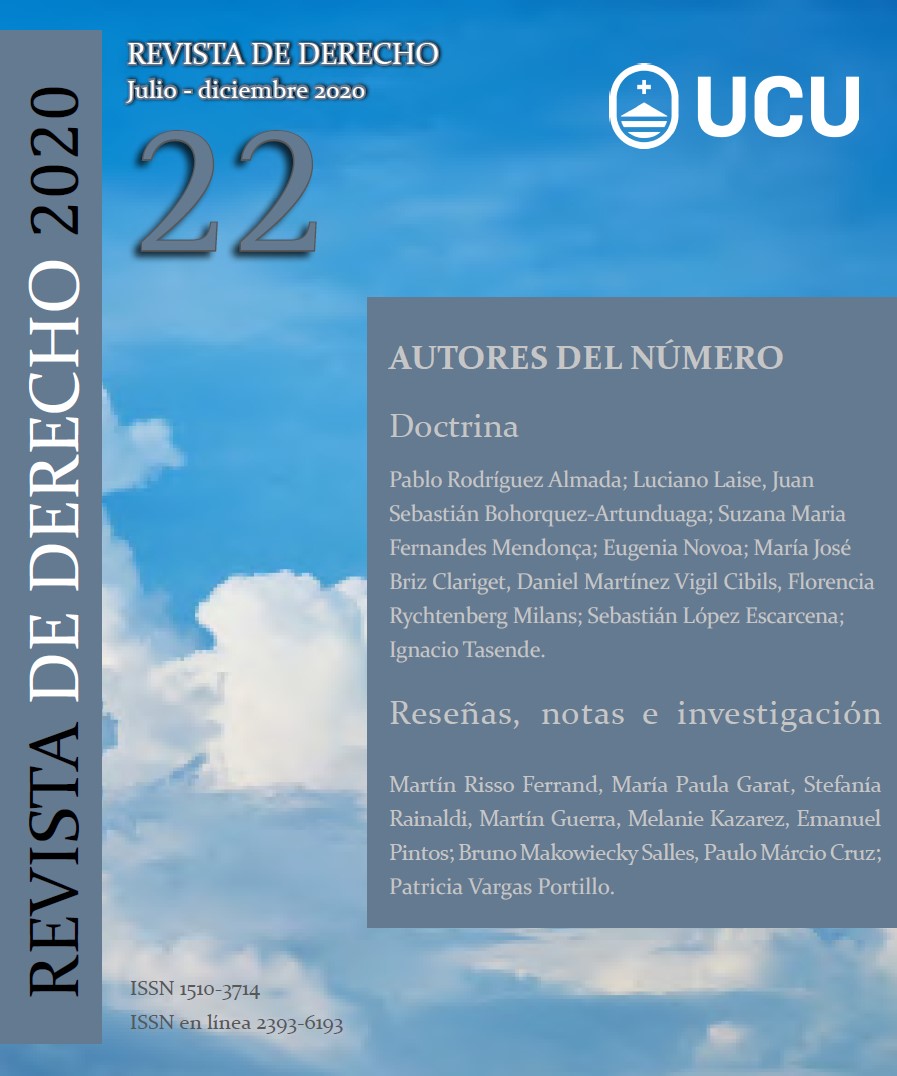Beyond Effect and Intention: Proportionality in Investment Arbitration
DOI:
https://doi.org/10.22235/rd22.2213Keywords:
foreign investment, treaties, indirect expropriation, proportionality, human rightsAbstract
Indirect expropriation is the prevailing form of expropriation today, and its determination constitutes one of the main problems in international investment law. Doctrine and case-law has identified two possible solutions centered, respectively, in the effects or in the intention of the measures adopted by the host state. Of late, a third alternative has appeared that finds possible support in certain last-generation investment treaties. Deriving from the case-law of the European Court of Human Rights on the protection of property, it applies the principle of proportionality to determine the expropriatory nature of those measures judicially challenged by foreign investors in international arbitrations. This possible solution, however, also presents some issues of implementation. The purpose of this work is to study the application of proportionality in these disputes. Through the analysis of the relevant case-law, and the use of the dogmatic and comparative methods, the present article examines the emergence of this principle in international investment law, highlighting the differences in its application in the fora in which it has been used, to conclude that in order to become a useful instrument for solving claims of indirect expropriation it must have a clear normative basis, allowing for its employment, in tandem with the margin of appreciation, to determine the lawfulness of the respective measures, not their expropriatory nature.
Downloads
References
Arai-Takahashi, Y. (2013). The Margin of Appreciation Doctrine: A Theoretical Analysis of Strasbourg’s Variable Geometry. En A. Føllesdal, B. Peters, & G. Ulfstein (Eds.), Constituting Europe: The European Court of Human Rights in a National, European and Global Context (pp. 62-105). Cambridge: CUP.
Asteriti, A. (2013). Regulatory Expropriation Claims in International Investment Arbitration: A Bridge Too Far? En A. Bjorklund (Ed.), Yearbook on International Investment Law and Policy 2012-2013 (pp. 451-473). Oxford: OUP.
Bonilla, D. (Ed.). (2009). Teoría del derecho y trasplantes jurídicos. Bogotá, Colombia: Uniandes.
Bücheler, G. (2015). Proportionality in Investor-State Arbitration. Oxford: OUP.
Calamita, N. J. (2014). The Principle of Proportionality and the Problem of Indeterminacy in International Investment Treaties. En A. Bjorklund (Ed.), Yearbook on International Investment Law and Policy 2013-2014 (pp. 157-200). Oxford: OUP.
De Nanteuil, A. (2017). Recent Developments in Expropriation Law: Towards a Better Protection of States’ Sovereign Interests? En T. El Ghadban, C-M. Mazuy, & A. Senegacnik (Eds.), La protection des investissements étrangers: vers une réaffirmation de l’état? / The Protection of Foreign Investments: A Reaffirmation of the State? (pp. 9-22). París, Francia: Pedone.
Dolzer, R., & Stevens, M. (1995). Bilateral Investment Treaties. La Haya, Países Bajos: Martinus Nijhoff.
Duggal, K. A. N., García Clavijo, D. F., Trujillo, S., & Rincón, M. C. (2019). Colombia’s 2017 Model IIA: Something Old, Something New, Something Borrowed. ICSID Review - Foreign Investment Law Journal, 34(1), 224-240.
Durney, M. (2013). Legal Effects and Implications of the Denunciation of the ICSID Convention on Unilateral Consent Contained in Bilateral Investment Treaties: A Perspective from Latin American Cases. En A. von Bogdandy, A. Peters, & R. Wolfrum (Eds.), Max Planck Yearbook of United Nations Law (pp. 221-304). Leiden, Holanda: Martinus Nijhoff.
Fortier, L. Y. (2009). The Canadian Approach to Investment Protection: How Far We Have Come! En C. Binder; U. Kriebaum, A. Reinisch, & S. Wittich (Eds.), International Investment Law for the 21st Century: Essays in Honour of Christoph Schreuer (pp. 525-543). Oxford: OUP.
Henckels, C. (2012). Indirect Expropriation and the Right to Regulate: Revisiting Proportionality Analysis and the Standard of Review in Investor-State Arbitration. Journal of International Economic Law, 15(1), 223-255.
Kingsbury, B., & Schill, S. W. (2010). Public Law Concepts to Balance Investors’ Rights with State Regulatory Actions in the Public Interest - the Concept of Proportionality. En S. W. Schill (Ed.), International Investment Law and Comparative Public Law (pp. 75-104). Oxford: OUP.
Kriebaum, U. (2007). Regulatory Takings: Balancing the Interests of the Investor and the State. Journal of World Investment & Trade, 8(5), 717-744.
Kulick, A. (Ed.). (2018). Reassertion of Control over the Investment Treaty Regime. Cambridge: CUP.
Legarre, S. (2007). The Historical Background of the Police Power. University of Pennsylvania Journal of Constitutional Law, 9(3), 745-796.
Lim, C. L. (2016). The Worm’s View of History and the Twailing Machine. En C. L. Lim (Ed.), Alternative Visions of the International Law on Foreign Investment: Essays in Honour of Muthucumaraswamy Sornarajah (pp. 3-42). Oxford: OUP.
López Escarcena, S. (2012). Interferences with Property under European Human Rights Law. Florida Journal of International Law, 24(3), 513-544.
López Escarcena, S. (2013). Expropriations and Other Measures Affecting Property Rights in the Case Law of the Iran-United States Claims Tribunal. Wisconsin International Law Journal, 31(2), 176-207.
López Escarcena, S. (2014a). Indirect Expropriation in International Law. Cheltenham: Edward Elgar.
López Escarcena, S. (2014b). La propiedad y su privación o restricción en la jurisprudencia de la Corte Interamericana. Ius et Praxis, 20(2), 531-576.
Lusa Bordin, F. (2018). Reasserting Control through Withdrawal from Investment Agreements: What Role for the Law of Treaties? En A. Kulick (Ed.), Reassertion of Control over the Investment Treaty Regime (pp. 209-229). Cambridge: CUP.
Mostafa, B. (2008). The Sole Effects Doctrine, Police Powers and Indirect Expropriation under International Law. Australian International Law Journal, 15, 265-296.
Mouyal, L. W. (2018). International Investment Law and the Right to Regulate: A Human Rights Perspective. Nueva York, NY: Routledge.
Perkams, M. (2010). The Concept of Indirect Expropriation in Comparative Public Law - Searching for Light in the Dark. En S. W. Schill (Ed.), International Investment Law and Comparative Public Law (pp. 107-150). Oxford: OUP.
Plater, Z. J., Abrams, R. H., Graham, R. L., Heinzerling, L., Wirth, D. A., & Hall, N D. (2010). Environmental Law and Policy: Nature Law and Society. Nueva York, NY: Wolters Kluwer.
Ranjan, P. (2014). Using the Public Law Concept of Proportionality to Balance Investment Protection with Regulation in International Investment Law: A Critical Appraisal. Cambridge Journal of International and Comparative Law, 3(3), 853-883.
Ranjan, P., & Anand, P. (2016). Determination of Indirect Expropriation and Doctrine of Police Power in International Investment Law: A Critical Appraisal. En L. Choukrone (Ed.), Judging the State in International Trade and Investment Law: Sovereignty Modern, the Law and the Economics (pp. 127-151). Ciudad de Singapur, Singapur: Springer.
Ruiz Fabri, H. (2003). The Approach taken by the European Court of Human Rights to the Assessment of Compensation for Regulatory Expropriations of the Property of Foreign Investors. New York University Environmental Law Journal, 1(1), 148-173.
Ruzza, A. (2017). Expropriation and Nationalization. En R. Wolfrum (Ed.), Max Planck Encyclopedia of Public International Law. Oxford: OUP.
Sacerdoti, G. (2015). New International Economic Order (NIEO). En R. Wolfrum (Ed.), Max Planck Encyclopedia of Public International Law. Oxford: OUP.
Salacuse, J. W. (2015). The Law of International Investment Treaties. Oxford: OUP.
Schabas, W. A. (2017). The European Convention on Human Rights: A Commentary. Oxford: OUP.
Stern, B. (2008). In Search of the Frontiers of Indirect Expropriation. En A. W. Rovine (Ed.), Contemporary Issues in International Arbitration and Mediation: The Fordham Papers 2007 (pp. 29-52). Leiden: Martinus Nijhoff.
Titi, C. (2015). International Investment Law and the European Union: Towards a New Generation of International Investment Agreements. European Journal of International Law, 26(3), 639-661.
UNCTAD. (2020a). Investor-State Dispute Settlement Cases Pass the 1,000 Mark: Cases and Outcomes in 2019. Nueva York, NY: ONU.
UNCTAD. (2020b). World Investment Report 2020. Nueva York, NY: ONU.
Vadi, V. (2014a). Proportionality, Reasonableness and Standards of Review in Investment Treaty Arbitration. En A. K. Bjorklund (Ed.), Yearbook on International Investment Law and Policy 2013-2014 (pp. 201-228). Oxford: OUP.
Vadi, V. (2014b). The Migration of Constitutional Ideas: The Strange Case of Proportionality in International Investment Law and Arbitration. En A. K. Bjorklund (Ed.), Yearbook on International Investment Law and Policy 2013-2014 (pp. 337-360). Oxford: OUP.
Vadi, V. (2015). The Migration of Constitutional Ideas to Regional and International Economic Law: The Case of Proportionality. Northwestern Journal of International Law & Business, 35(3), 557-589.
Vandevelde, K. J. (2009a). A Comparison of the 2004 and 1994 US Model BITs: Rebalancing Investor and Host Country Interests. En K. P. Sauvant (Ed.), Yearbook on International Investment Law and Policy 2008-2009 (pp. 283-315). Oxford: OUP.
Vandevelde, K. J. (2009b). U.S. International Investment Agreements. Oxford: OUP.
Vandevelde, K. J. (2010). Bilateral Investment Treaties: History, Policy, and Interpretation. Oxford: OUP.
Vandevelde, K. J. (2017). The First Bilateral Investment Treaties: U.S. Postwar Friendship, Commerce, and Navigation Treaties. Oxford: OUP.
Von Walter, A., & Andrisani, M. L. (2019). Resolution of Investment Disputes. En M. M. Mbengue, & S. Schacherer (Eds.), Foreign Investment Under the Comprehensive Economic and Trade Agreement (CETA) (pp. 185-206). Cham, Suiza: Springer.
Yannaca-Small, K. (Ed.). (2018). Arbitration under International Investment Agreements: A Guide to the Key Issues. Oxford: OUP.
Waibel, M., Kaushal, A., Chung, K-H. L., & Balchin, C. (Eds.). (2010). The Backlash Against Investment Arbitration. Perceptions and Reality. Alphen aan den Rijn, Países Bajos: Kluwer.
Wei, S. (2015). Expropriation in Transition: Evolving Chinese Investment Treaty Practices in Local and Global Contexts. Leiden Journal of International Law, 28(3), 579-604.
Jurisprudencia
“Archer Daniels Midland Company y Tate & Lyle Ingredients Americas, Inc. c/ México”, caso CIADI No. ARB (AF)/04/5 (Laudo, 21 de noviembre de 2007).
“Asian Agricultural Products Ltd. c/ Sri Lanka”, caso CIADI No. ARB/87/3 (Laudo, 27 de junio de 1990).
“Azurix Corp. c/ Argentina”, caso CIADI No. ARB/01/12 (Laudo, 14 de julio de 2006).
“Burlington Resources Inc. c/ Ecuador”, caso CIADI No. ARB/08/5 (Decisión sobre responsabilidad, 14 de diciembre de 2012).
“Chemtura Corporation c/ Canadá”, arbitraje CNUDMI (Laudo, 2 de agosto de 2010).
“Oscar Chinn (Reino Unido c/ Bélgica)”, CPJI (Sentencia, 12 de diciembre de 1934).
“Continental Casualty Company c/ Argentina”, caso CIADI No. ARB/03/9 (Laudo, 5 de septiembre de 2008).
“El Paso Energy International Company c/ Argentina”, caso CIADI No. ARB/03/15 (Laudo, 31 de octubre de 2011).
“Fireman's Fund Insurance Company c/ México”, caso CIADI No. ARB(AF)/02/1 (Laudo, 17 de julio de 2006).
“James y otros c/ Reino Unido”, TEDH (Sentencia, 21 de febrero de 1986).
“LG&E Energy Corp., LG&E Capital Corp., y LG&E International, Inc. c/ Argentina”, caso CIADI No. ARB/02/1 (Decisión sobre responsabilidad, 3 de octubre de 2006).
“Matos e Silva Lda. y otros c/ Portugal”, TEDH, (Sentencia, 16 de septiembre de 1996).
“Mellacher y otros c/ Austria”, TEDH (Sentencia, 19 de diciembre de 1989).
“Metalclad Corporation c/ México”, caso CIADI No. ARB(AF)/97/1 (Laudo, 30 de agosto de 2000).
“Methanex Corporation c/ EE.UU.”, arbitraje CNUDMI (Laudo, Parte IV, Capítulo D, 3 de agosto de 2005).
“Navieros Noruegos (Noruega c/ EE.UU.)”, Anderson, Vogt & Valloton, árbitros (Laudo, 13 de octubre de 1922).
“Occidental Petroleum Corporation y Occidental Exploration and Production Company c/ Ecuador”, caso CIADI No. ARB/06/11 (Laudo, 5 de octubre de 2012).
“Penn Central Transportation Co. c/ Ciudad de Nueva York”, Corte Suprema de EE.UU. (Sentencia, 26 de junio de 1978).
“Pennsylvania Coal Co. c/ Mahon”, Corte Suprema de EE.UU. (Sentencia, 11 de diciembre de 1922).
“Philip Morris Brands Sàrl, Philip Morris Products S.A. y Abal Hermanos S.A. c/ Uruguay”, caso CIADI No. ARB/10/7 (Laudo, 8 de julio de 2016).
“Pressos Compania Naviera S.A. y otros c/ Bélgica”, TEDH (Sentencia, 20 de noviembre de 1995).
“Saluka Investments B.V. c/ República Checa”, arbitraje CNUDMI (Laudo parcial, 17 de marzo de 2006).
“Sea-Land Service, Inc. c/ República Islámica de Irán y la Organización Portuaria y Naviera”, Tribunal de Reclamaciones Irán-EE.UU. (Laudo, 22 de junio de 1984).
“Técnicas Medioambientales Tecmed, S.A. c/ México”, caso CIADI No. ARB (AF)/00/2 (Laudo, 20 de mayo de 2003).
“Tippets, Abbett, McCarthy, Stratton c/ TAMS-AFFA Consulting Engineers of Iran, República Islámica de Irán et al.”, Tribunal de Reclamaciones Irán-EE.UU. (Laudo, 29 de junio de 1984).
“Total S.A. c/ Argentina”, caso CIADI No. ARB/04/01 (Decisión sobre responsabilidad, 27 de diciembre de 2010).
“Tza Yap Shum c/ Perú”, caso CIADI No. ARB/07/6 (Laudo, 7 de julio de 2011).
“Urbaser S.A. y Consorcio de Aguas Bilbao Bizkaia, Bilbao Biskaia Ur Partzuergoa c/ Argentina”, caso CIADI No. ARB/07/26 (Laudo, 8 de diciembre de 2016).














